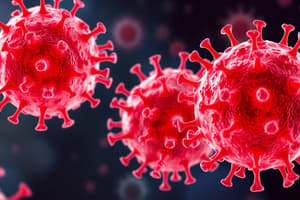Podcast
Questions and Answers
What characterizes the pathogenesis of type III hypersensitivity reactions?
What characterizes the pathogenesis of type III hypersensitivity reactions?
Type III hypersensitivity involves the formation of immune complexes from IgG and IgM antibodies binding to soluble antigens, leading to inflammatory reactions and tissue injury.
What is the time frame for the onset of systemic immune complex-mediated diseases in type III hypersensitivity?
What is the time frame for the onset of systemic immune complex-mediated diseases in type III hypersensitivity?
Symptoms typically occur 6-8 days after exposure to the foreign serum or antigen.
In type IV hypersensitivity, what is the primary immune cell type involved in the reaction?
In type IV hypersensitivity, what is the primary immune cell type involved in the reaction?
The primary immune cells involved are T lymphocytes.
How does type IV hypersensitivity differ from types I, II, and III hypersensitivity?
How does type IV hypersensitivity differ from types I, II, and III hypersensitivity?
What is the clinical manifestation of the Arthus reaction?
What is the clinical manifestation of the Arthus reaction?
What types of antibodies are primarily involved in the pathogenesis of type III hypersensitivity?
What types of antibodies are primarily involved in the pathogenesis of type III hypersensitivity?
Describe the role of complement fixation in type III hypersensitivity reactions.
Describe the role of complement fixation in type III hypersensitivity reactions.
What are common diseases associated with type III hypersensitivity?
What are common diseases associated with type III hypersensitivity?
What leads to the delayed response in type IV hypersensitivity reactions?
What leads to the delayed response in type IV hypersensitivity reactions?
How does the tissue injury occur in type III hypersensitivity reactions?
How does the tissue injury occur in type III hypersensitivity reactions?
What role do CD4 T-helper cells play in delayed hypersensitivity reactions?
What role do CD4 T-helper cells play in delayed hypersensitivity reactions?
Describe the Mantoux test and its significance in diagnosing tuberculosis.
Describe the Mantoux test and its significance in diagnosing tuberculosis.
Explain how granuloma formation occurs in the context of tuberculosis.
Explain how granuloma formation occurs in the context of tuberculosis.
What is the function of Th17 cells in the inflammatory response?
What is the function of Th17 cells in the inflammatory response?
Discuss the mechanism involved in allergic contact dermatitis.
Discuss the mechanism involved in allergic contact dermatitis.
How do CD8 T cells contribute to cell-mediated cytotoxic reactions?
How do CD8 T cells contribute to cell-mediated cytotoxic reactions?
What role do cytotoxic T cells play in type-1 diabetes?
What role do cytotoxic T cells play in type-1 diabetes?
Describe graft-versus-host disease and its underlying mechanism.
Describe graft-versus-host disease and its underlying mechanism.
How is chronic transplant rejection characterized at the immune level?
How is chronic transplant rejection characterized at the immune level?
Identify the main inflammatory cytokines involved in macrophage activation.
Identify the main inflammatory cytokines involved in macrophage activation.
Flashcards
Type III Hypersensitivity
Type III Hypersensitivity
An immune response mediated by antibodies, typically IgG and IgM, where antigen-antibody complexes form and deposit in tissues, triggering inflammation and tissue damage.
Serum Sickness
Serum Sickness
Acute reaction occurring 6-8 days after exposure to foreign serum, characterized by fever, joint pain, inflammation of blood vessels, and kidney problems.
Arthus Reaction
Arthus Reaction
Localized immune reaction in the skin, induced by antigen injection in previously sensitized individuals, resulting in inflammation and tissue necrosis.
Type IV Hypersensitivity
Type IV Hypersensitivity
Signup and view all the flashcards
Delayed Hypersensitivity
Delayed Hypersensitivity
Signup and view all the flashcards
Cell-mediated Hypersensitivity
Cell-mediated Hypersensitivity
Signup and view all the flashcards
Graft Rejection
Graft Rejection
Signup and view all the flashcards
Granuloma
Granuloma
Signup and view all the flashcards
Virus-Mediated Type IV Hypersensitivity
Virus-Mediated Type IV Hypersensitivity
Signup and view all the flashcards
Tumor-Mediated Type IV Hypersensitivity
Tumor-Mediated Type IV Hypersensitivity
Signup and view all the flashcards
CD4+ T-helper Cells (Th1/Th17)
CD4+ T-helper Cells (Th1/Th17)
Signup and view all the flashcards
Cell-Mediated Cytotoxic Reaction
Cell-Mediated Cytotoxic Reaction
Signup and view all the flashcards
CD8+ Cytotoxic T cells
CD8+ Cytotoxic T cells
Signup and view all the flashcards
Tuberculin Reaction (Mantoux Test)
Tuberculin Reaction (Mantoux Test)
Signup and view all the flashcards
Type 1 Diabetes
Type 1 Diabetes
Signup and view all the flashcards
Allergic Contact Dermatitis
Allergic Contact Dermatitis
Signup and view all the flashcards
Graft-versus-Host Disease
Graft-versus-Host Disease
Signup and view all the flashcards
Chronic Transplant Rejection
Chronic Transplant Rejection
Signup and view all the flashcards
Study Notes
Types of Immune Response
- Hypersensitivity reactions are categorized into types I-IV.
- Type III hypersensitivity is immune complex-mediated.
- It is mediated by IgG and IgM antibodies against soluble antigens (exogenous or endogenous), occurring 3-8 hours after exposure.
- Reactions can be localized or systemic.
- Antigen-antibody complexes form and deposit in postcapillary venules.
- Complement fixation leads to leukocyte recruitment, inflammation, necrotizing vasculitis, and tissue injury.
- Examples include serum sickness (an acute, self-limited disease following foreign serum injection), and localized reactions like the Arthus reaction (localized immune reaction causing tissue necrosis after antigen injection).
Type IV Hypersensitivity
- Also known as cell-mediated or delayed hypersensitivity.
- A T lymphocyte-mediated destruction of cells, along with dendritic cells, macrophages, and cytokines.
- Occurs 24−48 hours after antigen contact (delayed).
- Unlike types I-III, it is not antibody-mediated, but cell-mediated.
- This reaction is against persistent, non-degradable intracellular antigens.
- Activated by CD4+ T-helper cells (Th1 or Th17).
- Leads to the release of inflammatory mediators (e.g., IFNγ, IL-17).
- Macrophage transformation, leading to granuloma formation.
- Examples: tuberculin reaction (Mantoux test), granuloma formation (e.g., tuberculosis), fungal infection (mediated by Th17 cells), and allergic contact dermatitis.
CD8+ Cell-Mediated Cytotoxic Reaction
- Mediated by CD8+ T cells (cytotoxic T cells).
- Activated cytotoxic cells induce antigen-bearing cell apoptosis.
- Examples:
- Cytotoxic reactions against virus-infected cells and malignant cells.
- Type 1 diabetes (killing of pancreatic islet cells).
- Transplant rejection and graft-versus-host disease.
Studying That Suits You
Use AI to generate personalized quizzes and flashcards to suit your learning preferences.




